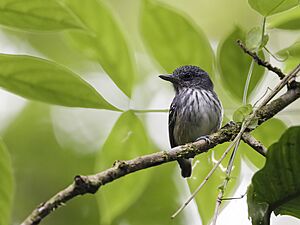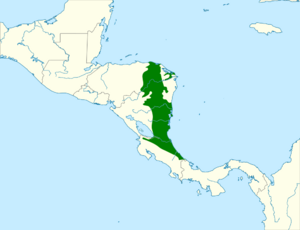Streak-crowned antvireo facts for kids
Quick facts for kids Streak-crowned antvireo |
|
|---|---|
 |
|
| Conservation status | |
| Scientific classification | |
| Genus: |
Dysithamnus
|
| Species: |
striaticeps
|
 |
|
The streak-crowned antvireo (scientific name: Dysithamnus striaticeps) is a small bird. It belongs to the "typical antbirds" family, called Thamnophilidae. You can find this bird in Costa Rica, Honduras, and Nicaragua. It's known for the unique streaks on its head.
Contents
What is a Streak-crowned Antvireo?
This bird is quite small, usually about 10 to 11 centimeters (4 to 4.3 inches) long. It weighs around 15 to 17 grams (0.5 to 0.6 ounces).
How to Identify a Male Antvireo
Adult male streak-crowned antvireos have a dark gray head with many grayish-white streaks. Their upper body is grayish-olive. Their wings are dark with buffy (light brownish-yellow) edges. Their tail is also dark with white tips. Their throat and chest are white with clear dark streaks. Their belly is whitish.
How to Identify a Female Antvireo
Adult females look a bit different. They have a reddish-brown (rufous) crown and neck with dark spots. Their wings are not as dark as the males'. Their chest and sides are a yellowish-brown color called ochraceous. Young males look similar to adult females but have grayer upper parts and whiter under parts.
Where Do Antvireos Live?
The streak-crowned antvireo lives in parts of Central America. You can find them in southeastern Honduras, through Nicaragua, and most of Costa Rica. They also live in northern Costa Rica, reaching into Guanacaste Province.
Antvireo Habitat
These birds prefer to live in the lower and middle parts of evergreen forests. They are usually found in lowlands and foothills. Sometimes, but less often, they live in older secondary forests (forests that have grown back after being cut down). They can be found from sea level up to about 400 meters (1,300 feet) high in Honduras. In Nicaragua and Costa Rica, they live up to 800 meters (2,600 feet) high.
Antvireo Behavior
Movement and Home Range
Scientists believe that the streak-crowned antvireo stays in the same area all year round. It does not migrate to different places.
What Do Antvireos Eat?
The streak-crowned antvireo mainly eats insects. Its diet also includes other small creatures like spiders. These birds usually look for food alone or in pairs. They often join "mixed-species feeding flocks," which are groups of different bird species feeding together.
They typically feed between 1.5 and 8 meters (5 to 26 feet) above the ground. They are careful eaters, usually picking food from leaves, vines, and branches while perched. They also make short flights to grab prey from overhanging leaves.
Reproduction and Life Cycle
The streak-crowned antvireo breeds in Costa Rica between March and June. The breeding season in other areas is not yet fully known.
- Nests: They build a cup-shaped nest. It is usually made from fern fibers with moss on the outside. Sometimes, moss hangs below the nest. The nest is often placed in the fork of a branch, about 1.5 to 4 meters (5 to 13 feet) above the ground.
- Eggs: A female usually lays two eggs.
- Parental Care: Both the mother and father bird take turns sitting on the eggs (incubating them). They also both feed and care for the baby birds once they hatch. The eggs hatch after at least 14 days. We don't know how long it takes for the young birds to leave the nest.
Antvireo Sounds
The song of the streak-crowned antvireo is a long series of notes. The notes start high in pitch and get louder. Then they stay the same, and finally, they get shorter, weaker, and lower in pitch. People have described its song as "kepkepkepkepkepkrrrrrrr" or "peu-peu-peu-Peu-Peu-Peu-Pip-Pip-Pip-Pip'Pip'Pip'Pip'Pip'peu". Its calls include soft single or double whistles and a short "chirr."
Conservation Status
The IUCN (International Union for Conservation of Nature) has listed the streak-crowned antvireo as a species of "Least Concern." This means it is not currently in danger of disappearing.
However, its living area is somewhat limited. The total number of these birds is unknown, but it is thought to be decreasing. There are no immediate threats identified for this bird. It is generally common to uncommon in its range. It is rare to uncommon in Honduras and very uncommon in the Caribbean lowlands of Costa Rica. Even though forests are being cleared for farming, this bird lives in several protected parks and reserves in Costa Rica. These protected areas help keep its populations safe.


